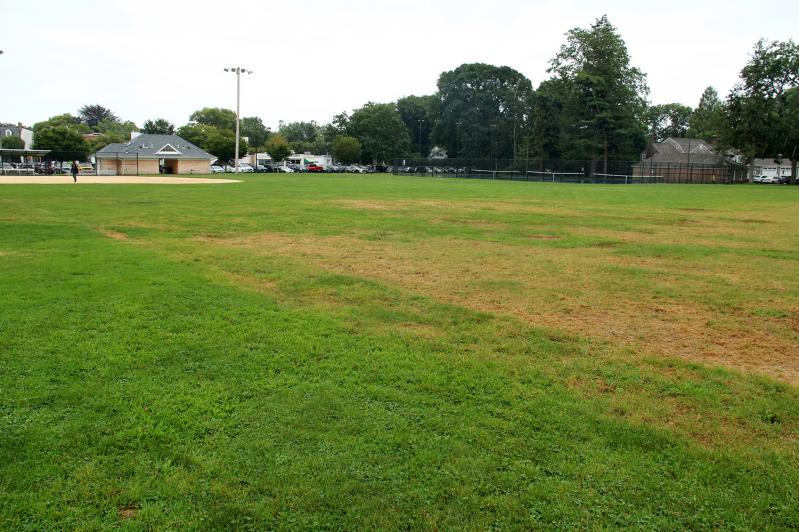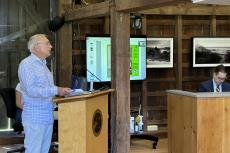Little by little, Herrick Park is changing.
At the Aug. 18 East Hampton Village Board meeting, Mayor Jerry Larsen applauded the recent work done by LandTek to reconstruct the tennis courts and playing fields, saying the park “was in desperate need of repair.”
At the same meeting, the board voted unanimously to use $240,416 from the general fund to pay LandTek for its design to reconstruct the Roy Lee Mabry Memorial Basketball Courts, near the Newtown Lane entrance to the park. So far, over $1 million in improvements have been paid for by the East Hampton Village Foundation, with no tax dollars used.
But not everyone is thrilled with the way things are proceeding, and questions have been raised about the larger plan for the park and the connected Douglas E. Dayton Arboretum.
“Frankly, if there are no plans beyond the tennis courts and the baseball fields, they’re not doing their job,” said Arthur (Tiger) Graham, a former village trustee who ran against Mr. Larsen in the last election.
“No one can use it. The children can’t play there. The mayor is making it for the benefit of private events. Every week all summer he has something in the park,” Barbara Bebon said in mid-August from her house that shares a long property line with Herrick Park. “It’s changing from a place of quiet enjoyment, strollers and babies, to a major hub. It’s not Eisenhower Park. This is a small village playground,” she said.
Indeed, a large white tent had been erected for days prior to the East Hampton Library’s Authors Night fund-raiser, first held in the park only last year. After it was removed a large area of matted, yellowed grass was revealed.
Herrick Park was deeded from The East Hampton Neighborhood Association to the village for $10 in 1976. The deed contains restrictive covenants, which were noted in the village’s 2002 comprehensive plan: “The village has a policy of not permitting special events at the park, with two exceptions. Each year the Ladies Village Improvement Society uses a portion of the park for its annual fund-raising fair. The park is also used for the annual Artists-Writers Softball Game.”
The village has held 13 events in the park so far this year. “Maybe that was the village policy at the time,” said Marcos Baladron, the village administrator, of the 2002 comprehensive plan language. “We allow village nonprofits to use the park for cultural events that promote community. We’re totally into that. It seems that Mr. Bebon woke one day to learn the fact that he lives next to a public park.”
He mentioned it was time for the comprehensive plan to be revisited.
In mid-April, the Bebons filed an Article 78 lawsuit against the Village of East Hampton and Mayor Larsen to stop the construction of pickleball courts feet from their house. They went ahead with the lawsuit even though in an April 6 work session, the village board had agreed to remove the courts, with a nod to neighbor complaints. In July, Suffolk County Supreme Court Justice Joseph Santorelli tossed the suit.
“We didn’t lose that suit,” said Michael Bebon at the meeting. “We wanted pickleball removed and you did it.”
“We proceeded with the lawsuit anyway because we wanted to stop the construction of an ice-skating rink and bandshell,” said Ms. Bebon. Since April, Mr. Bebon has appeared at the East Hampton Village Board meetings, sometimes alone, sometimes with lawyers, not once wavering from his story that in late March, Mayor Larsen showed him and his wife plans for the park that included an ice-skating rink and permanent bandshell.
Meanwhile, Mayor Larsen has steadfastly denied such plans exist.
“When he says we showed up with a complete set of drawings that’s absolutely not true,” Mayor Larsen said in a phone call. “We spoke about putting a stage where the basketball courts were, with the speakers pointed away from his house, but that wasn’t drawn on the plan. And I also had thoughts about putting an ice rink where the tennis courts were, but those were just ideas I was throwing out.”
“I don’t have any reason not to be truthful,” said Mr. Bebon. “We’ve lived here for 18 years. We’ve given money to the L.V.I.S. and tried to be good neighbors. We’re in favor of renovating the park. I just think the mayor and the board want to do it their way and that’s it. There’s zero transparency.”
At the board meeting, Mr. Bebon used the public comment period to question the village’s environmental review of the park improvements. “My family, and a lot of people I know, are in favor of the basketball courts. We are not in favor of a negative SEQRA; people don’t know what you want to do.” A negative declaration under the State Environmental Quality Review Act means that the agency overseeing a project, in this case the village board, does not believe it will cause significant environmental impacts.
Billy Hajek, the village planner, explained to the board that he evaluated the reconstruction of the basketball courts and “based on my assessment, I did not identify any significant impacts on the environment and recommended a negative declaration.” The board agreed unanimously with Mr. Hajek’s determination.
Indeed, Mayor Larsen indicated that the first two phases of the park were merely reconstructions and “no big deal.”
However, in their lawsuit, the Bebons also accused the village of “impermissible segmentation” of the environmental review of the park.
“Segmentation” is a word that often comes up when large projects are evaluated under the SEQRA process. In the past, courts have recognized that cutting a large project into many smaller projects may result in ignoring the cumulative impact. If there are future phases that are not laid out yet, there isn’t a full understanding of the cumulative environmental impact of the entire project.
The fourth edition of the SEQR Handbook deals with this issue specifically.
“Sometimes the project sponsor has a definite plan for future development, and other times the future projects are merely wishful thinking. It is up to the lead agency to determine if the project is the ‘whole action’ or merely a part or segment of the action that should be reviewed. If there is evidence of a plan, then there is a strong presumption that the larger project is the ‘whole action’ and should therefore be the subject of the environmental review.”
Is there a larger plan? It’s not clear. There’s certainly a plan to make a plan.
“The next step after we get these basketball courts in is probably going to take a couple of years,” said Mayor Larsen. “We’ll convene a committee and then figure out what we want to do with the kids’ stuff. We’ve also acquired a couple areas off of Muchmore Lane like the Schulman parcel. And do we want to put something on the Dayton parcel? We’re not sure. Plus, we don’t have any money right now. We have to start fund-raising.”
At the meeting earlier this month, Mayor Larsen said a public hearing about expanding the definition of Herrick Park would be delayed. “Instead of rushing it, we’re going to take more time” he said. At the July meeting, when the village introduced the law, Mr. Bebon and his lawyers spoke out strongly against it. The law would also have to run the SEQRA gauntlet. In short, the village can’t change a law in a way that’s going to increase impacts in the park without considering the changes it is trying to facilitate.
“I think he’s shocked that the Bebons showed up,” said Mr. Bebon. “I’ve already spent $100,000 on this, and I’ll spend more. I feel strongly. This is our home.” Meanwhile, Ms. Bebon struck a conciliatory tone. “It’s our hope that we can have a friendly exchange with Jerry and the board, and everyone can agree on what’s best for everyone here.”




